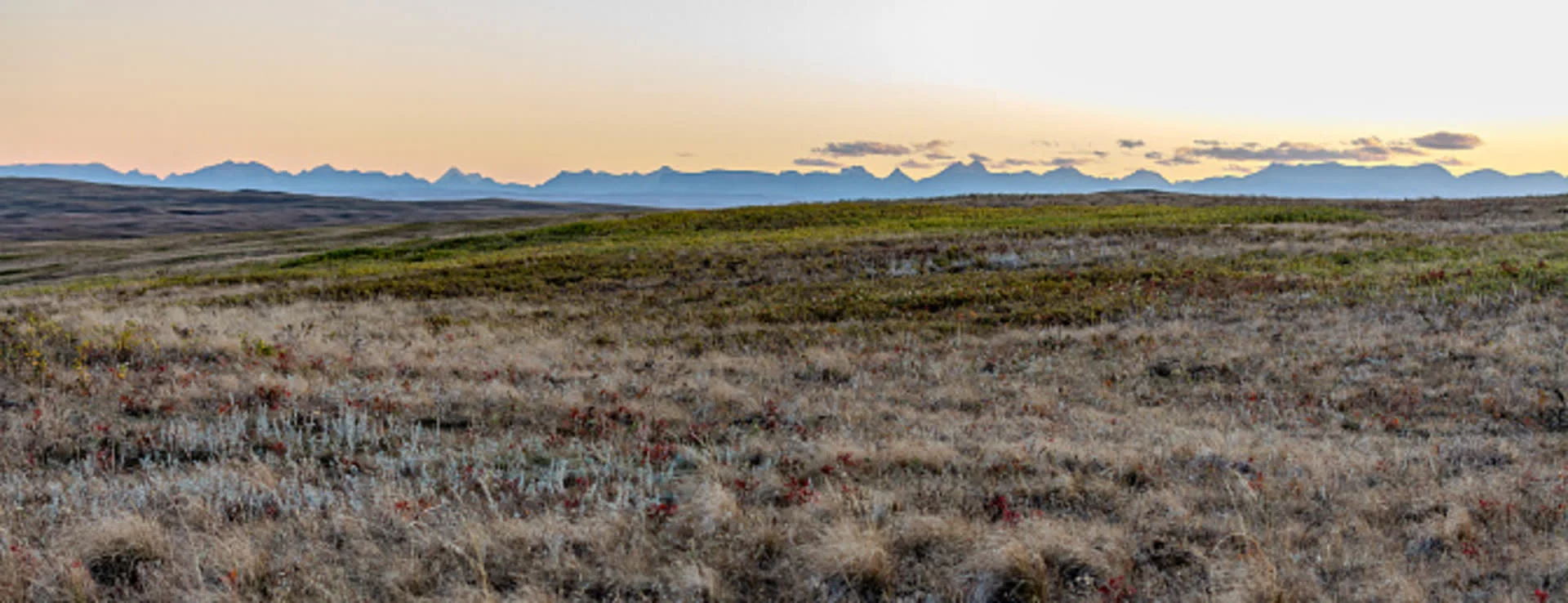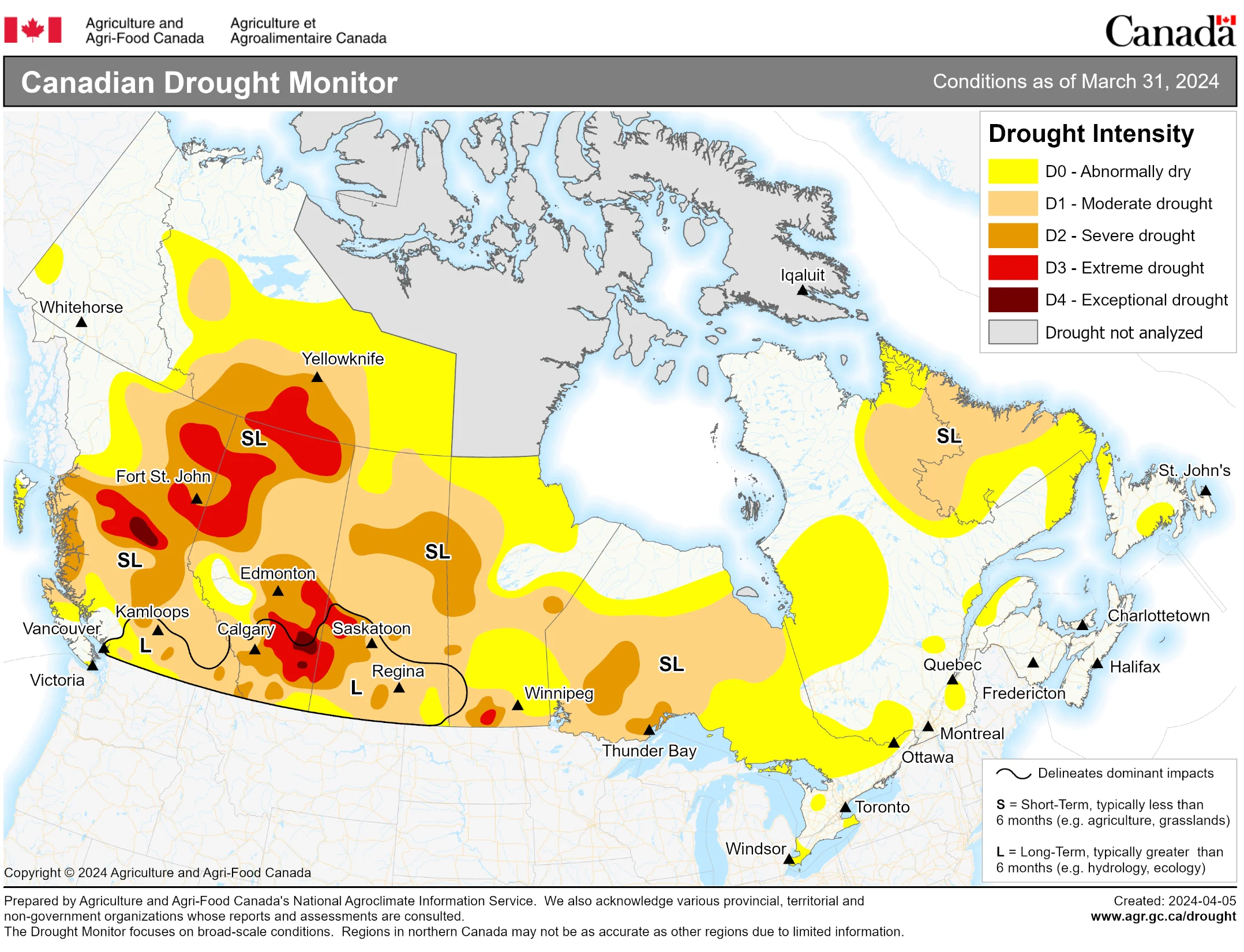
Alberta outlines the drought conditions that would lead to state of emergency
Alberta's environment ministry says it is watching three triggers closely to determine whether or not emergency declarations are used to respond to drought this year.
The province has five stages on the books as part of its water management response plan. Currently, the province is at stage four, which includes water-sharing agreements announced last month.
Under stage five, Alberta would declare an emergency under the Water Act. That's provincial legislation that came into effect in 2000 which governs the management and protection of water resources.
Emergencies would be applied to specific locations — and they could range, for instance, from small areas within a sub-basin to the entire South Saskatchewan River Basin or province, the government says.
If an emergency were to be declared, relevant water-sharing agreements would be superseded
Such an emergency has never been declared under the Water Act, the province said.
In addition to water licences, the framework would allow the government to suspend approvals and registrations, and to designate how water is diverted and used.

Canada's drought conditions as of March 31, 2024. (Source: Agriculture and Agri-Food Canada)
RELATED: Forthcoming, soggy weekend on the Prairies will be helpful for summer
The province said it would consider three triggers prior to declaring emergencies on a case-by-case basis:
Whether there is sufficient water available for priority uses. The government said the highest priority is human health and safety, followed by ensuring a sufficient water supply for critical infrastructure, livestock welfare and critical environmental needs.
Whether there is "increasing distress" from local authorities, or if local authorities are not able to respond to issues posed by drought. The province says that could involve if a state of local emergency is declared, or if the Provincial Emergency Coordination Centre is activated at level three or higher.
Whether Alberta's water management system becomes "so overwhelmed" that staff can't process or implement regulatory measures in a timely manner.
In an interview with CBC News in mid-April, Alberta Environment Minister Rebecca Schulz said conditions weren't yet sufficient to move to stage five.
"We do have water within the system. The users are all coming together," Schulz said. "Every drop we can not use, or we can conserve, is a drop of water that can be used by somebody downstream."
She added the province was waiting for data on peak snowpack levels before announcing its next steps to respond to drought conditions.
That data is currently being analyzed, the environment ministry said, and water-sharing agreement participants will be meeting next week to review and assess what action is needed, if any.
Drought conditions persist
Though parts of Alberta have been hit recently with a spring storm that brought heavy, wet snow to some regions, drought conditions develop over a period of time much longer than one week.
The province is seeing 51 water shortage advisories for select water management areas across the province. Every little bit of precipitation helps, and above-average precipitation in parts of the province has surely brought relief to farmers in mid-central Alberta.
"The rain has helped with the soil saturation. That's helped to improve drought conditions in localized pockets of the province. But again, I want to stress localized pockets," said Tricia Stadnyk, a professor and Canada Research Chair in hydrologic modelling with the University of Calgary's Schulich School of Engineering.
"This is not, by any means, something that we're seeing province-wide, and it certainly hasn't really overall impacted the drought conditions."
Perhaps to no surprise, the areas of the province facing the biggest challenges right now remains its semi-arid south. The environment ministry said the Oldman basin remains the most concerning in the province, though other areas remain at risk of drought.
RELATED: What’s the recipe for a severe drought in Western Canada?
That includes the southern irrigation districts, Stadnyk said. In April, the St. Mary River Irrigation District, the bigger such district in the country, said farmers would get half the amount of water allocation they receive in a good year.
"Anywhere that is feeding off, or would normally feed off the Oldman reservoir, is still in a critical state of drought. Not much has changed. Their water supplies have not rebounded," Stadnyk said.
"Unfortunately, there is not a lot of snowpack to draw from in those mountains. Even as we head towards warmer conditions, we're not expecting the amount of snowmelt that's going to be adding to that system to help pull it out of the drought state."
Last year, dropping levels in the Oldman reservoir forced the Municipal District of Pincher Creek to haul water, leading to a price tag of more than $1 million. That's because the M.D.'s intakes in the nearby reservoir breached the surface, making it impossible to draw water.
In an attempt to avoid a similar situation this year, the M.D. decided to construct a $1.7-million underground intake project in an attempt to draw water from below the surface, connected to the Crowsnest River.
But the M.D. was facing off against a ticking clock, with the risk of the reservoir filling up with spring runoff before construction concluded. Sometimes, runoff starts at the end of April, but in the past it's also started around the middle of the month.
WATCH: Drought solutions - How Alberta is planning for a drier future
In an interview on Wednesday, David Desabrais, who manages utilities and infrastructure with the M.D. of Pincher Creek, said the reservoir has been filling up, but it hasn't yet seen the steep increase seen last year.
"Once that very steep increase starts, we'll have very limited time to work in the reservoir. But based on current trends, we're expecting to be able to complete the work in the reservoir before the levels rise past our constructability area," Desabrais said.
That's good news, but the M.D. isn't out of the woods yet. There's still a lot of precipitation in the forecast, and there are still a few things that can go wrong with construction. And even should construction complete successfully, the M.D. still expects they'll enact water restrictions this year.
"Because of the severity of the anticipated continuation of this drought across the basin," Desabrais said.
"We'll be continuing to do our part. I think we'd expect our downstream neighbours to be doing the same."
When asked if the situation faced by Pincher Creek last year was a good example of a situation that could trigger the declaration of an emergency, a spokesperson with the province wrote in a statement that reaching a single indicator or trigger would not necessarily be a sign that such an emergency would be declared.
"There may be other management options, including regulatory actions, that may ease or mitigate the circumstances without requiring that an emergency be declared," reads the statement.
"For example, the department is already working closely with Pincher Creek to put its backup system in place and helping the community access water."
WATCH: Are rain barrels worth the effort? Here are the benefits
Some have already called for stage five
In mid-April, Alberta released the details of four agreements zeroing in on major water users in the Red Deer River sub-basin, the Bow River sub-basin, and the mainstem and upper tributaries of the Oldman River sub-basin.
They saw municipalities, industry and irrigation districts agreeing to reduce water use.
The agreements are voluntary given Alberta's "first in time, first in right" priority system, which grants seniority to those who had water licences in the province first (for instance, operations who received a licence in 1900 have access to water first, compared to an operation which received a licence in 1980).
But the voluntary approach to water sharing didn't satisfy groups like the Alberta Wilderness Association, which suggested the water sharing plan prioritized industry and irrigation over the environment, and called on the government to declare a stage five emergency so as to give itself additional avenues to respond.
"Instead, it seems that the [government] is content to rely upon the good will of licensed users through non-binding agreements that they may enter or exit at any time," reads a release issued April 19 by the organization.
In an interview with CBC News in April, Schulz said the province was seeking to respect "first in time, first in right," while also moving water allocations online, to better understand who holds water allocations and encourage water conservation.
"We know that as our population grows, as our industry grows to create jobs for those people that are choosing to call Alberta home, we need to make sure that we're maximizing our water allocation," Schulz said.
This article, written by Joel Dryden, was originally published for CBC News on May 2.
Header image Credit: Meadowmouse via iStock / Getty Images Plus. Creative #: 1831502892. Stock photo used for illustration purposes only.









